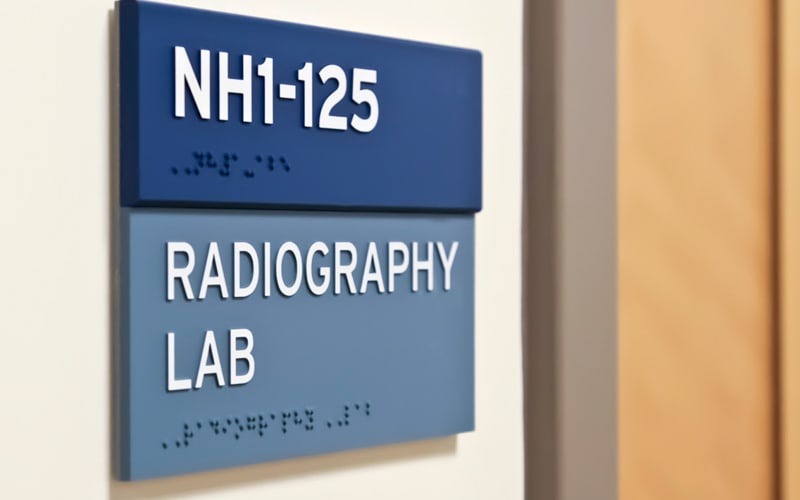ADA Signs: Important Devices for Inclusive Environments
ADA Signs: Important Devices for Inclusive Environments
Blog Article
Discovering the Key Functions of ADA Indications for Improved Availability
In the realm of availability, ADA indications offer as silent yet effective allies, guaranteeing that spaces are accessible and inclusive for individuals with disabilities. By incorporating Braille and responsive aspects, these indicators break obstacles for the aesthetically impaired, while high-contrast shade schemes and readable fonts cater to varied aesthetic needs.
Importance of ADA Conformity
Ensuring compliance with the Americans with Disabilities Act (ADA) is essential for cultivating inclusivity and equal accessibility in public spaces and work environments. The ADA, established in 1990, mandates that all public facilities, employers, and transport services fit people with disabilities, ensuring they take pleasure in the exact same civil liberties and opportunities as others. Compliance with ADA criteria not just meets lawful responsibilities however also enhances a company's credibility by demonstrating its dedication to diversity and inclusivity.
One of the crucial elements of ADA conformity is the implementation of available signage. ADA signs are created to make sure that individuals with specials needs can easily browse with spaces and structures.
In addition, sticking to ADA laws can alleviate the risk of legal consequences and prospective fines. Organizations that stop working to abide by ADA guidelines might deal with fines or legal actions, which can be both harmful and financially challenging to their public picture. Hence, ADA conformity is important to fostering a fair environment for everybody.
Braille and Tactile Components
The incorporation of Braille and tactile components right into ADA signage embodies the principles of availability and inclusivity. It is generally put under the equivalent text on signage to guarantee that individuals can access the info without visual support.
Tactile components expand past Braille and include raised personalities and symbols. These components are made to be noticeable by touch, permitting individuals to determine space numbers, bathrooms, departures, and other critical locations. The ADA establishes specific guidelines regarding the size, spacing, and positioning of these tactile aspects to enhance readability and make sure consistency across different environments.

High-Contrast Color Design
High-contrast color design play a critical role in boosting the visibility and readability of ADA signage for individuals with visual problems. These plans are important as they maximize the distinction in light reflectance between text and history, making sure that signs are quickly discernible, even from a range. The Americans with Disabilities Act (ADA) mandates using particular shade contrasts to fit those with minimal vision, making it a vital aspect of conformity.
The effectiveness of high-contrast shades hinges on their capability to stand out in different lighting problems, including poorly lit settings and areas with glare. Generally, dark message on a light background or light text on a dark history is used to achieve optimum contrast. For example, black message on a white or yellow background supplies a stark aesthetic difference that aids in fast acknowledgment and understanding.

Legible Fonts and Text Dimension
When taking into consideration the layout of ADA signage, the choice of readable typefaces and appropriate text size can not be overstated. These aspects are crucial for ensuring that signs are accessible to individuals with visual impairments. The Americans with Disabilities Act (ADA) mandates that font styles have to be sans-serif and not italic, oblique, script, highly attractive, or of uncommon kind. These needs assist make sure that the message is conveniently readable from a range which the personalities are distinct to varied audiences.
According to ADA standards, the minimal text elevation see this site ought to be 5/8 inch, and it should boost proportionally with seeing distance. Uniformity in text dimension contributes to a natural visual experience, aiding people in navigating settings efficiently.
Furthermore, spacing between letters and lines is indispensable to legibility. Ample spacing avoids personalities from showing up crowded, improving readability. By sticking to these requirements, developers can substantially improve accessibility, ensuring that signs serves its intended function for all individuals, no matter their aesthetic abilities.
Reliable Placement Methods
Strategic positioning of ADA signs is necessary for making the most of availability and making sure compliance with lawful criteria. ADA standards specify that indicators need to be placed at a height between 48 to 60 inches from the ground to guarantee they are within the line of view for both standing and seated people.
In addition, indications must be positioned nearby to the lock side of doors to permit easy recognition before access. Consistency in indicator positioning throughout a facility improves predictability, reducing complication and improving general customer experience.

Final Thought
ADA indicators play an essential duty in advertising accessibility by integrating functions that attend to the requirements of individuals with impairments. These aspects collectively promote an inclusive environment, underscoring the importance of ADA conformity in making certain equivalent accessibility for all.
In the realm of ease of access, ADA signs serve as quiet yet powerful allies, ensuring that areas are inclusive and accessible for people with specials needs. The ADA, passed in 1990, mandates that all public centers, employers, and transportation solutions fit individuals with specials needs, ensuring they enjoy the very same legal rights and chances as others. ADA Signs. ADA signs are made to ensure that people with impairments can easily browse through rooms and structures. ADA guidelines specify that signs need to be placed at a height in between 48 to 60 inches from the ground to ensure they are within the line of sight for both standing and seated people.ADA signs play an see this essential role in promoting ease of access by incorporating functions that resolve the demands of individuals with handicaps
Report this page